Banarsi Fabric
Banarsi Fabric for formal and festive wear
Banarsi fabric as sarees, suits and silk fabric is one of the most traditional materials used for bridal and party wear clothes. Sarees of this material have been worn by the beautiful women of the Indo-Pak region since centuries. Originating from Varanasi, also called Banaras, in India, the craft has been carried to Pakistan by the artisans that migrated here and continues to be identified as such.
From product development including designing to the final garment, each step is taken with meticulous care to maintain the regal beauty of this fabulous fabric.

Banarsi Fabric - Historical Significance
The tradition of Banarsi weaving dates back several centuries, with historical references suggesting that it was introduced during the Mughal era. The Mughals were instrumental in developing the art of weaving, combining Persian motifs with Indian craftsmanship to create the unique Banarasi silk patterns we see today.
Initially it was woven with real gold thread called zari. The artisans that designed the floral motifs as well as the full 'palloo' of the Saree have command over intricate design development as well as color combination.
Made for the Nawab Begums, Maharanis, the royalty and the nobility all wore Sarees and lehngas at all special occasions, made of this regal fabric made from zari and resham.
Banarsi Fabric - Characteristics
Intricate Designs: Banarsi silk is famous for its elaborate patterns, which often include floral and foliate motifs, kalga and bel, and a string of upright leaves called jhallar at the outer edge of the border. The designs are typically inspired by Mughal art and architecture.
Zari Work: One of the defining features of Banarsi silk is the use of zari, which involves weaving gold or silver threads into the fabric. This gives the sarees and other garments a shimmering effect and adds to their opulence.
Variety of Weaves: Banarsi silk comes in various types, including pure silk (Katan), organza (Kora) with zari and silk, georgette, and shattir. Each type has its own unique characteristics and is used for different occasions and purposes.
Durability and Sheen: The quality of the silk and the density of the weave make Banarsi silk highly durable. The fabric is known for retaining its sheen and beauty over time, making it a preferred choice for heirloom pieces.
Banarsi Fabric - Uses
- Weddings: Banarsi silk is a staple in Indian and Pakistani weddings. Bridal sarees, lehengas, and even groom’s sherwanis are often made from this luxurious fabric. The richness of the fabric enhances the grandeur of wedding attire. It is frequently used with traditional Pakistani clothing, particularly for weddings and other formal events. The fabric comes in a variety of textures, including silk, brocade, and tissue, and is frequently woven with threads of gold and silver, giving it an opulent appearance. Pakistani weddings are not complete without banarsi fabric, especially for bridal outfits. This beautiful fabric, which represents grace and cultural legacy, is frequently used to create the bride's lehenga, gharara or saree and the groom's sherwani. For such important occasions, the cloth is a popular choice because of its elaborate motifs and luster.
- Festive Wear: Beyond weddings, Banarsi silk is also popular for festive occasions such as Eid-ul-Fitr, Eid-ul-Azha, birthday parties and other cultural and general celebrations. Its opulent appearance makes it ideal for such events. Banarsi fabric is popular not only for bridal gowns but also for formal wear and festive occasions. It is a prized addition to any wardrobe because of its exceptional durability and capacity to hold its beauty over time.
- Fashion Industry: Designers frequently incorporate Banarsi silk into their collections, blending traditional craftsmanship with contemporary fashion trends. This has helped in keeping the art form alive.
Banarsi Fabric - Sarees and their types
There are many types of Banarsi sarees, from brocade to silk to organza. The main types can be divided in four categories i.e. georgette, shattir, pure silk (katan) and organza (kora). While georgette sarees made from fine nylon material are used more in contemporary styles. Shattir is the base fabric which is used for making simple sarees. Pure Silk or Katan is the pure silk that is woven into sarees. organza is the brocade fabric used for making Banarsi sarees with silver thread and silk as warp and weft.
Sarees are further categorized based on designs as well. The age old traditional names are tanchoi, jangla, cutwork, tissue and butidaar. The designs are developed for various styles and patterns.
Banarsi Fabric - Sarees
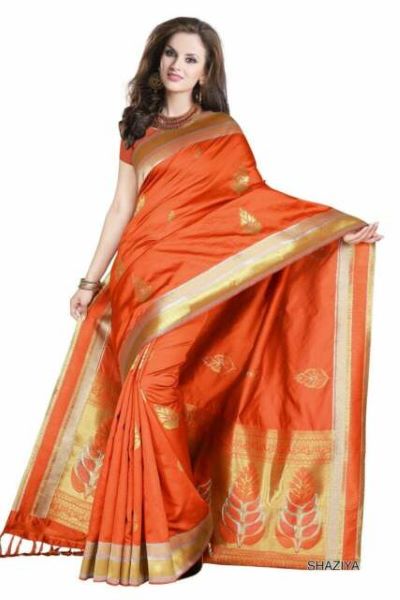 Banarsi Orange Gold saree
Banarsi Orange Gold saree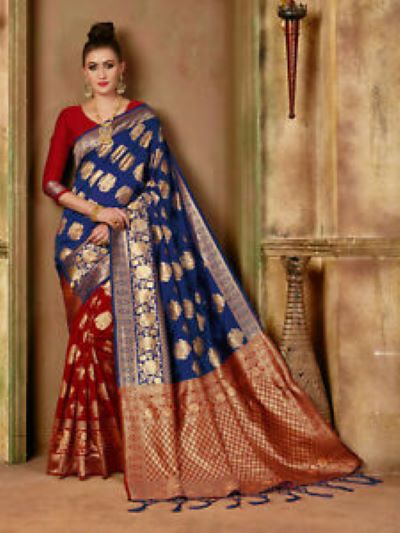 Banarsi-blue-red-gold-saree
Banarsi-blue-red-gold-saree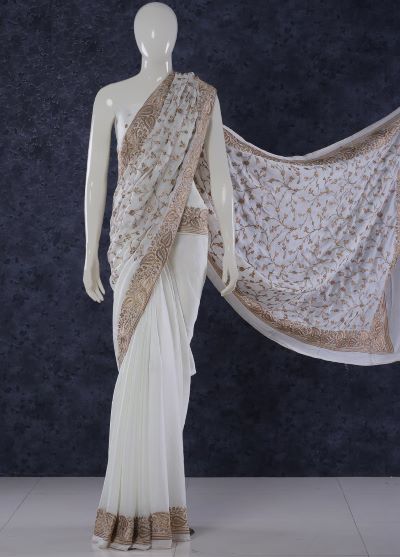 White Gold saree
White Gold saree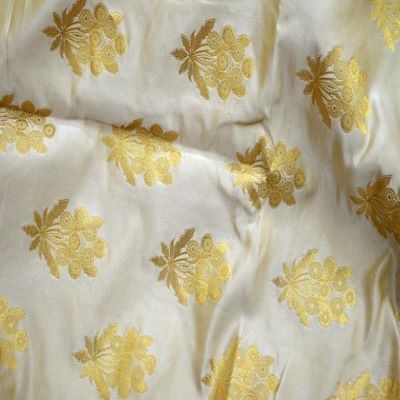 Ivory Gold Brocade saree
Ivory Gold Brocade saree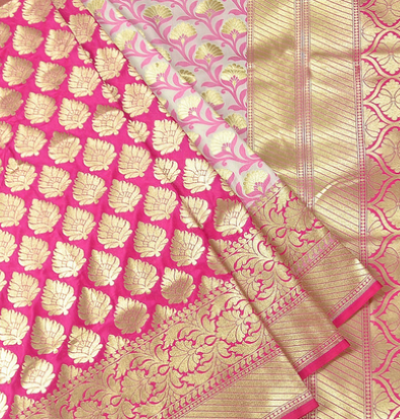 Katan Magenta Gold saree
Katan Magenta Gold saree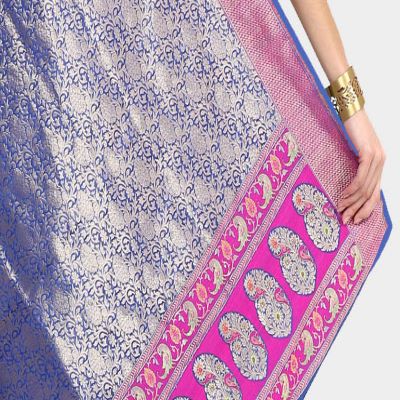 Banarasi-Paisley Silk saree
Banarasi-Paisley Silk sareeBanarsi Fabric - Suits
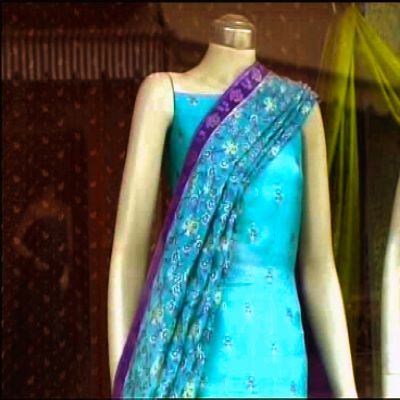 Banarsi Blue Navy Suit
Banarsi Blue Navy Suit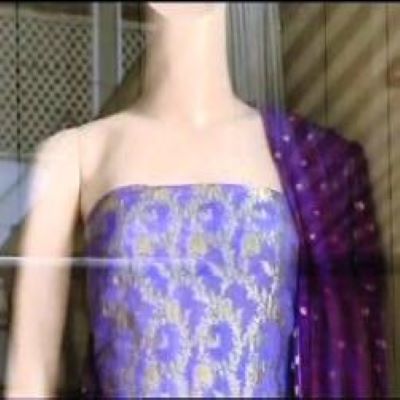 Banarsi Purple Silver Suit
Banarsi Purple Silver Suit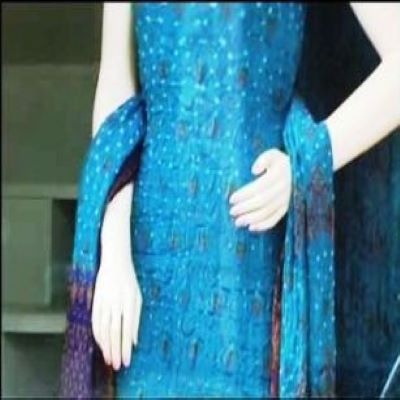 Banarsi Tie and Dye Suit
Banarsi Tie and Dye SuitBanarsi Fabric - how it is made
Pure Silk Thread
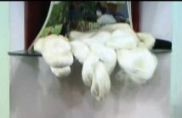 Pure Silk Thread
Pure Silk ThreadTraditionally the fabric is made from pure silk thread. However, due to its high cost there are some variants such as polyester fiber that have replaced the traditional silk thread. Nevertheless, old artisans still use silk thread and despite being costlier, the demand for banarsi silk has always been high.
Pure Silk Thread Wash
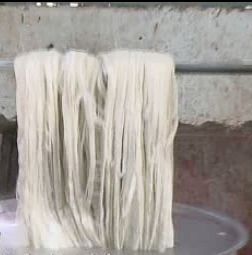 Pure Silk Thread Wash
Pure Silk Thread WashPure silk thread imported in loops as shown above is then washed in large vats to clean the fiber of any impurities.
Thread Detangled
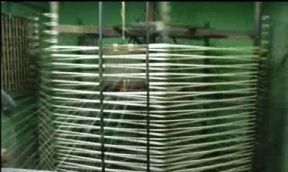 Thread Detangled
Thread DetangledOnce washed and dried, the thread is then placed on the de-tangling machine to have long smooth lengths to be rewound on spools. These spools are packaged
Silk Thread on Spools
 Silk Thread on spools
Silk Thread on spoolsThe detangled fiber is then rewound on spools for better management and ease of movement.
Weaving of Fabric
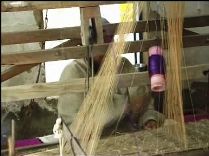 Weaving of Fabric
Weaving of FabricBanarsi fabric is woven on hand looms made out of wood. This is a traditional way of weaving this fabric. Along with silk fiber motifs are added with Zari thread which has many colors as well as gold and silver.
Woven Fabric
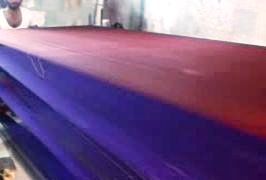 Woven Fabric
Woven FabricWoven fabric is in lengths with repeated designs. the lengths are then cut into Sarees or suit pieces according to the design and specifications.
Cropping Thread
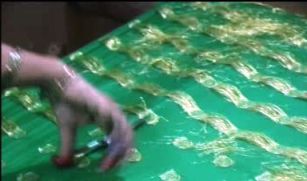 Cropping Thread
Cropping ThreadMost of the finishing work is done in the houses of the weavers where women give full help in clipping away the extra material.
- Home
- Pakistani Bridalwear
- Banarsi Fabric


